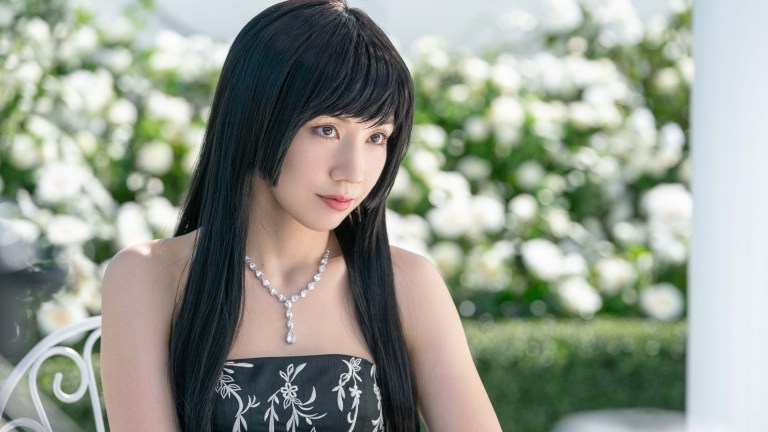Alice in Borderland: Every Alice in Wonderland Easter Egg
Even with a name like Alice in Borderland, the Netflix series has way more Alice in Wonderland references than you might expect.

This article contains Alice in Borderland spoilers through season 2.
In case the title doesn’t make it glaringly obvious, Netflix’s Alice in Borderland is the J-horror VR altverse answer to the Alice in Wonderland realm. The Wonderland that emerged from Lewis Carroll’s imagination was adapted into an animated Disney classic in 1951. The Netflix version was adapted from the manga of the same name that reimagines Wonderland into Tokyo video game scenes splattered with blood. Season 2 has brought even more games—and with them suspense and confusion. Once Borderland’s Alice, Arisu, goes down this rabbit hole, there may be no way out.
Borderland may seem the opposite of the story that inspired Disneyland’s whimsical spinning teacup ride. However, whether you’re a diehard fan of the Carroll canon or prefer the animated psychedelia Disney conjured, you may notice some unsettling similarities. It starts with card suits and a white rabbit, escalating to an urban version of chess played with human pieces. And the Queen of Hearts? She doesn’t need to wear red.
Arisu is Alice
Arisu is obviously Alice, if his name doesn’t give it away first (“Arisu” is the Japanese phonetic version of “Alice”). The series is about his journey, and though you do see this twisted VR Wonderland from the points of view of other characters, it always returns to Arisu. There is some foreshadowing in the beginning when he is caught up in the virtual word of a video game and is jolted back into reality. Unfortunately, reality becomes that game in Borderland.
The empty building is the rabbit hole
When Arisu, Chota, and Karube find themselves trapped in an empty room and unknowingly cross into the VR world, they are at least metaphorically tumbling down the infamous rabbit hole of Alice in Wonderland. Alice also grows and shrinks after ingesting the “eat me” and “drink me” potions. While there are no potions in Borderland, the effect comes from the characters being squeezed into that room, then lost in a massive empty building.
Usagi is the White Rabbit
Undoubtedly Usagi (whose last name translates to “rabbit” in Japanese), the White Rabbit in Borderland has several things in common with the character she was inspired by. Wonderland’s White Rabbit is elusive. He is always running somewhere, and Alice is always chasing him, much like Arisu is always chasing Usagi in Borderland. She trains for games by running. Another throwback to Alice in Wonderland is what she hunts—rabbits, of course.
Chota and Karube are Tweedledum and Tweedledee
Chota and Karube might not look identical, but one is Tweedledum to the other’s Tweedledee and vice versa. In Alice and Wonderland, these characters—who actually emerged from a nursery rhyme before Lewis Carroll’s fairytale—are always playfully fighting. So are the walrus and the carpenter in the nonsense poem they recite to Alice. Like the walrus, Karube is more of a trickster, and Chota, like the carpenter, believes hard work will get him what he wants.
The Hide and Seek botanical garden is the Tulgey Wood
In Alice in Wonderland, the Tulgey Wood is a seemingly endless forest where Alice is easily lost and runs into bizarre creatures. In a futuristic upgrade, the botanical garden in Hide and Seek is the Tulgey Wood in the Borderland universe. While the characters are not chased down by a Jabberwock or Frumious Bandersnatch analog (that happens later), they all might as well be vicious predators because each “lamb” can turn into the “wolf” with a look in the eye. This is when Borderland becomes the inside-out version of Wonderland, because lambs hunt the wolf.
The Light Bulb room is the Pool of Tears
When Alice grows distraught from being lost in Wonderland, she cries so much that her tears overflow into what becomes the Pool of Tears. Arisu is forced into another game right after losing Chota and Karube to Hide and Seek. While he doesn’t cry enough to fill an entire room, Light Bulb is a symbolic game, since the inescapable room (with electrical wires showering sparks from the ceiling). It keeps filling with water as an already traumatized Arisu tries to keep it together but almost breaks down trying to stay alive. He might as well be crying.
Chishiya is the Cheshire Cat
Chishiya not only has a name that is a Japanization of “Cheshire”, but while he doesn’t sound entirely bonkers like the cat that materializes in Wonderland, he often confuses his competitors even further with the way he figures out what sick machinations are behind each game, whether you are hearing his thoughts or he is baffling others. He might be Borderland’s most cunning character. Though Chishiya might not grin, his lips are often curling into a sly smile. His mantra? “I’ve always loved messing with people who try too hard at life.”
Hatter is (obviously) the Mad Hatter
Takeru Danma earned the Hatter moniker for a reason. He is the boss of the Beach, a haven of debauchery where almost every vice is legal, just like anything goes at the mad tea party in Alice in Wonderland. Unlike Wonderland, where nothing is supposed to make sense, the Borderland beach is an endless frat party because Hatter reasons everyone should be able to let loose before most of them inevitably drop dead in one game or another.
Aguni and Samura are the Jabberwock and the Frumious Bandersnatch
There are predators lurking at the Beach. Both the Jabberwock and the Bandersnatch are fearsome carnivores in Wonderland, but they take on human form in Aguni and Samura. Aguni may be more monstrous, murdering Hatter and usurping his power before setting all his subjects on a bloody witch hunt, but don’t underestimate the katana in Samura’s hand. Also, in Season 1’s carousel beast game, the tiger may recall the yellow-eyed Bandersnatch.
Niragi is the March Hare (and just as mad as one)
Rifle-happy Beach militant Niragi, who breaks out shooting whenever he feels like it, is the lethal human form of the villainous hare who infuriates Alice with trickery. He would rather ditch the tricks and beat Arisu to a pulp. Niragi is so unhinged that he still keeps shooting on impulse even after Chishiya hurls a flamethrower at him and leaves him severely disfigured and coughing up blood. Half-dead as he is, he manages to survive somehow and later tries to start his own game by taking shots at Chishiya and Arisu. Talk about being “mad as a March hare”.
An is the White Queen
An, who appropriately wears a white shirt as one of the many visual references to Alice in Wonderland characters, mirrors Wonderland’s White Queen as a voice of reason. She goes one step further by letting the others in on the motive or modus operandi of a master or player in a game after her forensic examination of evidence. She uses a tube of superglue to search for fingerprints on the knife that killed Momoka, who tend out to be the “witch” all along. Enter another voice of reason—Kuina.
Kuina is the Caterpillar, sans mushroom and hookah
Along with An, Kuina is the other character who mentally dissects game situations in Borderland. Like the Caterpillar in Wonderland shows a disgruntled (and shrunken) Alice how to grow back to her normal height just by sharing a bite of his iconic mushroom, Kuina figures out the twists that can get her allies out of a game alive. As a nod to the hookah-smoking Caterpillar, Kuina is often seen with an unlit cigarette dangling from the side of her mouth in an attempt to quit smoking.
Mira is the Queen of Hearts
Borderland’s Queen of Hearts does everything heartless short of shouting “Off with their heads!” Much like her mirror character in Wonderland, Mira (translated from Japanese as “queen of”) has a sick fascination with watching the helpless denizens of her universe struggle to beat games that literally mean life and death. Both of them are thrilled to take lives whenever the opportunity shows itself. Mira might not directly murder everyone or have the temper of Wonderland’s Queen of Hearts, but she loves nothing more than to bask in blood.
The Tag building is the garden of the Queen of Hearts
Yes, Mira does have an actual garden that is revealed at the end of Season 2, but her labyrinthine hedge maze, which Alice easily loses herself in, is reimagined for Borderland as a building that is easily entered but nearly impossible to leave. It is also the stage for a kill-or-be-killed game of tag where shooters in horse masks—known as “oni”, which often manifest as demons in Japanese folklore—can appear at every turn.
The Queen’s swarms of militants are the card soldiers
Just like the Queen of Hearts’ loyal force of fighting cards in Wonderland, Borderland’s evil queen has an entire army of militants at her disposal, and both obey their leader without question. Not all militants wear their card suits. However, they are emblazoned on the zeppelins looming overhead, and it can be argued that players are turned into card militants when they are assigned different suits for games such as Osmosis and Checkmate.
Checkmate is the human game of chess
Checkmate is the upgraded version of the life-size chess game the Queen of Hearts forces Alice to play in Wonderland. This one is run by the Queen of Spades (but technically still technically the Queen of Hearts since she remains Borderland’s overlord). Even more terrifying is that one team is the Queen’s team, and this team, which has the advantage for most of the game. The advantage seems to mean certain death for their opponents.
Croquet is what it sounds like, but scarier
Alice plays a peculiar game of flamingo croquet in Wonderland, but Borderland’s take is much more dangerous. It appears deceptively easy—but any weapon can be brought in. Mira’s weapon of choice is hallucinogenic tea that makes her especially dangerous. Croquet is a deceptive name for the last game of the series. The real challenge happens mentally, when Arisu keeps trying to claw his way towards answers about what Borderland really is while the Queen lies over and over.
The Mad Tea Party is a break from Croquet, and even more nonsensical
The Borderland version of the Mad Tea Party is intertwined with croquet, with the Queen of Hearts, who is basically on an acid trip, spouting fantastical things that make “twinkle twinkle little bat” almost make sense. Are Arisu and Usagi being targeted by aliens? Is the whole thing really virtual reality or scorched, bloodstained reality? Her declaration that “nothing beyond your imagination is possible here” is something Lewis Carroll would be proud of.
The blood of innocents paints the proverbial roses red
In Wonderland, Alice finds some humanoid cards painting the white roses in the Queen’s garden red because they accidentally planted the wrong color. This is a metaphor that spans the entire realm of Borderland—the blood of innocents. It is most obvious towards the end of Season 2, when Arisu and Usagi, both in white, end up bleeding both in the garden (white roses and all) and in the psych ward where the Queen is their therapist.
Borderland is Wonderland
Wonderland or Borderland, this is a place the characters fall into only to experience strange, often nonsensical and possibly dangerous (especially in Borderland) encounters. Borderland is plagued by as much senseless death as Wonderland is by senseless words and creatures. Both make the characters question what is real and what reality even is. Whether it’s a fantasy land or a video game, such an altverse is designed to confuse, but it also just might reveal an answer.
Alice in Borderland season 2 is available to stream on Netflix now.
